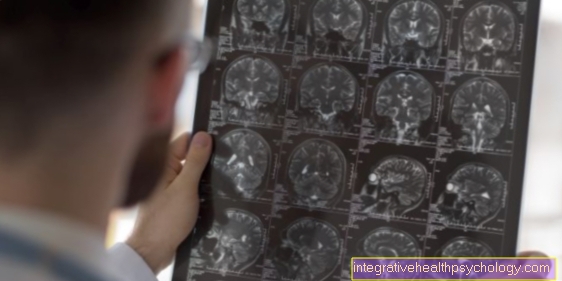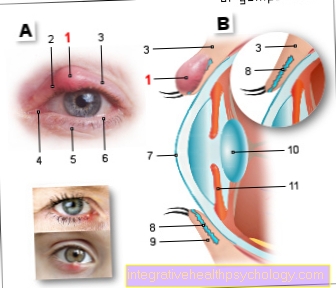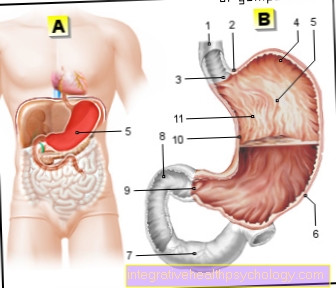Hepatitis C.
Synonyms in the broadest sense
Liver inflammation, liver parenchymal inflammation type C, acute and chronic viral hepatitis C, hepatitis C virus (HCV), infectious jaundice of virus type C, hepatitis non-A-non-B (NANB), post-transfusion hepatitis
definition
Hepatitis C is inflammation of the liver caused by the hepatitis C virus and most commonly transmitted through blood and blood products (pareneral). Compared to hepatitis A and hepatitis B, this reportable form of viral hepatitis becomes chronic particularly frequently, in up to 80% of cases.
A patient with chronic hepatitis C has a higher risk of liver cirrhosis and / or liver cancer (hepatocellular carcinoma, hepatocellular carcinoma, HCC). Treatment of chronic hepatitis C is possible through antiviral therapy with interferon, but unfortunately not always successful. A prophylaxis of hepatitis C by vaccination is currently not possible.

Symptoms
Overview of the symptoms of hepatitis C disease:
-
No symptoms (up to 75% of cases)
-
Acute infection:
-
fatigue
-
Exhaustion
-
Light fever
-
Joint pain
-
a headache
-
Nausea, loss of appetite
-
Pain in the right upper abdomen (below the costal arch)
-
Jaundice
-
-
Chronic infection:
-
Jaundice
-
Fatigue, weakness
-
Joint pain
-
Loss of appetite
-
Pain in the upper right abdomen
-
New tendency to bruise
-
Inflammation of the blood vessels
-
itching
-
Acute hepatitis C infection is symptom-free (asymptomatic) in 75% of cases. However, asymptomatic acute hepatitis C infections very often become chronic.
Only 25% of those infected show unspecific complaints such as tiredness, exhaustion, nausea, vomiting or right-sided upper abdominal pain. In about 25% of symptomatic patients, there is also yellow discoloration of the skin (jaundice), eyes (scleric terus) or mucous membranes. Dark discoloration of the urine and discoloration of the stool are also possible. However, in acute symptomatic hepatitis C, 50% of the patients heal completely.
In most cases (80%) an acute hepatitis C infection develops, which is associated with fatigue, decreased performance, loss of appetite, joint pain, diarrhea and pain in the liver (under the right costal arch). Some patients also experience itching, dry skin or oral mucosa, and disease of the kidneys or thyroid gland. In addition, a chronic hepatitis C infection can lead to increased anxiety and depression.
Male patients sometimes also complain of an enlargement of the breasts (gynecomastia) and a reduction in the size of the testicles (Testicular atrophy) and decrease in hair on the stomach (Bald head) and in the pubic area. In chronic hepatitis C patients, on the other hand, menstrual disorders and a missed menstrual period (Amenorrhea) come.
However, these chronic complaints usually only appear many years after being infected.
A consequence of chronic hepatitis C infection is the development of liver cirrhosis, which leads to the destruction of liver cells and excessive formation of connective tissue (Fibrosis) comes. The liver can no longer carry out its normal tasks. For example, the formation of coagulation factors is restricted so that bleeding can occur. In addition, the development of a liver coma (hepatic encephalopathy) is possible as a result of the liver's lack of detoxification function.
Liver cirrhosis can ultimately lead to liver failure, i.e. a complete loss of liver function, or to the development of liver cancer (e.g. hepatocellular carcinoma / HCC).
causes
In the vast majority of cases, the causes of a hepatitis C infection are the transmission of the virus through blood contact. On the one hand, poor hygiene standards for tattoos, piercings or the use of syringes and needles (especially in the drug scene), on the other hand blood products (blood transfusions), organ transplants or blood washing (dialysis) come into question. Transmission through needlestick injuries or other blood contact between hepatitis C infected people and medical personnel is also possible. There is also a low residual risk of virus transmission via semen or breast milk from a person infected with hepatitis C.
Transmission of the virus from an infected pregnant woman to the unborn child is around 5% in a normal, complication-free birth.
After infection, the virus multiplies within the liver cells and is subsequently released into the blood. As a result, the virus can then spread and multiply unchecked throughout the newborn's body.
Read more at: Causes of hepatitis C.
Pathogen and transmission
The hepatitis C pathogen belongs to the Flaviviridae family and is an RNA virus. There are 6 different subgroups of the hepatitis C virus (HCV). In Germany, types 1,2,3 are most common. In Africa, on the other hand, type 4 is more common. The main difference between these sub-types is their response to interferon therapy. Types 2 and 3 respond better to this therapy than the others.
Humans are the only possible host for HCV, i.e. only humans get the virus. The transmission paths cannot always be traced.
However, people who have a lot of contact with blood and blood products belong to the greatest risk group. These include those in need of transfusion, dialysis, i.v. Drug addicts, people who have had a needlestick injury such as tattoos and piercings on contaminated instruments, or medical staff who carelessly handle the blood of infected people. Sexual transmissions have been described in very rare cases.
The transmission of the virus from mother to child is estimated at around 5% in a normal birth.
Read more on the topic: Causes of Hepatitis C
Genotypes
The hepatitis C virus is an RNA virus of which 6 genotypes have been identified so far. In addition, the hepatitis C virus can be divided into about 100 subtypes. The respective genotypes show differences in the genetic make-up. The genotypes 1a, 1b, 2a, 2b, 3a, 3b, 4, 5 and 6 are known. In Europe and North America, genotypes 1-3 occur in particular, genotype 1 has a share of almost 80% in Germany. Genotype 4 is mainly found in Africa.
What do the different genotypes mean?
The different genotypes are based on a difference in genetic makeup. Therefore, the different genotypes have different characteristics in response to different drugs. Genotype 1b, for example, is more resistant to interferon therapy than other types. The genotype of the hepatitis C virus determines the type and duration of therapy. Also, some genotypes are more aggressive than others. Types 1 and 3 are associated with more severe damage and an increased risk of liver cirrhosis and liver cancer. If you have been infected with a particular hepatitis C genotype, infection with a different genotype is still possible.
infection
A hepatitis C virus is usually infected through blood contact. If infected blood - even small amounts, such as from an already used syringe, are sufficient - brought into the bloodstream of a healthy person, infection is very likely. The risk of infection via blood products (e.g. as part of a transfusion) or organ transplantation is extremely low thanks to very good tests nowadays. Transmission via sexual contact and from mother to child is also possible, but often plays a subordinate role. Most infections occur in the drug scene or from tattooists and piercers.
Further information on this topic can be found at: Way of transmission or infection of hepatitis C
Way of transmission of hepatitis C.
The hepatitis C virus is transmitted through the blood; it is called a parenteral route of transmission. Vulnerable groups of people are intravenous drug addicts who share syringes with other drug addicts. You can also become infected with hepatitis C if you use drugs through your nose if you share the aspiration tube with others. In the event of a needlestick injury or a cut, medical staff can, e.g. infected in the operating room, the risk is one to three percent if the patient in question has a hepatitis C infection.
In the past, many hepatitis C infections were passed on via a blood transfusion, especially patients with a congenital bleeding disorder (haemophilia) or other diseases that required frequent transfusions, therefore got hepatitis C. Better testing of the canned food increases the risk of getting hepatitis C through a blood transfusion is now only 1: 1 million. Hepatitis C can also be transmitted through sexual intercourse, but rarely. With unprotected anal intercourse, the risk of damage to the mucous membranes is higher and the risk of infection is higher than with vaginal intercourse. Transmission of hepatitis C from a sick mother to her unborn child is also possible if the mother has a high viral load in the blood. In up to 45% of all cases, the cause of a hepatitis C infection cannot be determined.
Read more on the topic: Way of transmission or infection of hepatitis C
Can you get hepatitis C from a tattoo?
When tattooing, dye is introduced into the second layer of skin with the help of a needle (tattoo machine). Here it can be permanently deposited, so the tattoo remains visible. This procedure injures small blood vessels, so the needle comes into contact with the tattooed person's blood. If the tattoo artist works with poor hygienic standards, for example if the instruments are insufficiently sterilized, blood from one tattooed person can get under the skin of the next. Transmission of hepatitis C when tattooing is therefore possible, but only if work is carried out under poor hygienic conditions and with non-sterile needles.
Can you get sick from a blood transfusion?
In the past, the risk of developing hepatitis C after a blood transfusion was almost 4%, but modern blood testing methods have now reduced the risk to 1: 200,000.
Frequencies
Worldwide around 3% of the population are chronically infected with the hepatitis C virus, in Germany this is Contamination 0.5%. That means there are around 400,000 infected people in Germany. Around 5000 new diseases occur every year. It should be mentioned that by all Drug addicts (intravenous drug administration) in Germany 80% are HCV carriers.
The disease becomes chronic in 50 to 80% of those infected. At 30%, this results in an on average after 20-30 years Cirrhosis of the liver and cirrhosis of the liver can develop in around 5% of those affected Hepatocellular carcinoma (hepatocellular carcinoma/HCC) develop.
incubation period
The incubation period for hepatitis C is relatively variable. Acute hepatitis with the symptoms mentioned above and an increase in liver values occur in around 25% of infected people after an average of 6-7 weeks. The incubation period can be just two weeks long or stretch over six months. The problem is that in many cases, hepatitis C has no symptoms. 75% of infected people do not notice the disease even after the maximum incubation period of six months has elapsed because they do not show any signs of the disease. The liver is still damaged.
Read more on the topic: Symptoms of hepatitis C.
diagnosis
Since there are often no relevant symptoms, elevated liver values are not infrequently only noticeable during a routine examination. Then the doctor orders further diagnostics to rule out viral hepatitis.
In the case of hepatitis C diagnostics, this includes an antibody search test, whereby the formation of anti-HCV antibodies does not start until after 4-6 weeks at the earliest. In addition, the antibodies can be false-positive, especially if there is cirrhosis of the liver or alcoholic hepatitis.
The determination of the hepatitis C virus RNA using the PCR method (polymerase chain reaction) is part of the proof of infection.
A positive anti-HCV antibody titer in the case of HCV-RNA (virus genome) measured negatively several times within approx. 3 months indicates that hepatitis C has been through but healed.
In contrast to hepatitis A / B, the liver values (transaminases) in the blood are often independent of the severity or stage of the hepatitis and can therefore not be used as a reliable marker for the actual course of the disease. A tissue sample from the liver (liver biopsy) is suitable for assessing the course of the disease.
Further information on general hepatitis diagnostics can be found on our website: Hepatitis B.
Hepatitis C test
The test for hepatitis C infection is carried out using a blood sample.
A so-called HCV ELISA screening test is carried out, which checks whether there are antibodies against the virus in the blood or not. If this search test is positive, another test, a so-called HCV immunoblot, is carried out to confirm. If this is also positive, one can assume a hepatitis C infection. However, these tests cannot differentiate whether the infection is acute, chronic or healed. Further tests can determine how high the viral load is in the blood (i.e. how active the infection is) and which genotype of the virus caused the infection. '
The test for hepatitis C can be carried out at the family doctor, at the health department or at special test centers (set up e.g. for patients with regular drug use).
More on this topic: Hepatitis C test and Rapid hepatitis C test
Which antibodies can be detected in the blood in case of hepatitis C?
The body makes anti-HCV antibodies that are directed directly against the hepatitis C virus. These antibodies can be detected in the blood one to five months after the onset of the disease and exist as antibodies of the IgM and IgG groups.
However, this classification has no clinical relevance (yet). In the case of chronic hepatitis C, it is also possible that autoreactive antibodies directed against the body's own components, e.g. ANA (anti-nuclear antibodies) and anti-LKM1.
Read more on the topic: antibody
Who pays the costs?
The test for hepatitis C is covered by the statutory health insurance if there is a specific suspicion of infection. This means that you either have symptoms that could be related to an infection with hepatitis C, that you belong to a risk group (e.g. intravenous drug use, sex workers) or that a specific event (e.g. unprotected sexual intercourse with an infected person) has taken place. In specially set up test centers for people who belong to risk groups, the test is usually free of charge, otherwise costs of 20-30 € can be expected. Depending on the range of services provided by the health insurance company, the test may also be paid for by default; this can be requested from the insurance company. The doctor who would like to have the test carried out can provide more information.
How quickly do I get a result?
It takes about 1-2 days to get a result after taking your blood for the test for hepatitis C. If the test is e.g. performed during a hospital stay, it can be a little faster. With a resident doctor, it can sometimes take a little longer, depending on the laboratory with which this doctor works. The test for hepatitis C is positive no earlier than six weeks after infection. If the test is negative six months after the suspected infection event, an infection can be ruled out.
Complications
Cirrhosis of the liver
About 80% of all infections with hepatitis C in adulthood are chronic infections that cause no symptoms at the beginning of the disease and are therefore discovered late. The hepatitis C virus has a damaging influence on the liver cells and puts them under chronic "stress". Therefore, within 20 years, the liver cells of 20% of these patients are so badly damaged that liver cirrhosis develops. The liver cells react to the constant presence of the hepatitis C virus with the formation of new connective tissue, like scars. In addition, there is a nodular remodeling of the liver structure. Cirrhosis of the liver is incurable and is the common end stage of many liver diseases.
Read more on the topic: Cirrhosis of the liver
Liver cancer
The ongoing damage to liver cells by the hepatitis C virus leads, as explained above, to liver cirrhosis. Cirrhosis of the liver can develop into liver cancer, which doctors refer to as hepatocellular carcinoma (HCC). Every year about two to five percent of patients with cirrhosis of the liver develop liver cancer. Patients with risk factors in addition to infection with the hepatitis C virus are at an increased risk. Factors include alcohol consumption, fatty liver disease, and infection with another hepatitis virus.
Read more on the topic: Liver cancer
therapy
It is basically possible to cure an infection with a hepatitis C virus (HCV); the treatment is exclusively medicated. While complete healing can occur in most cases, this is not always the case.
The aim of treating a hepatitis C infection is always to inhibit the virus from multiplying in the patient's body. However, the therapeutic approaches differ depending on the virus type (genotype) and stage (acute/chronic) from each other.
The acute hepatitis C infection is treated with a so-called peginterferon alpha, which stimulates the immune cells (T lymphocytes) to cause a defense reaction against the virus. If this medication is taken weekly for approx. 24 weeks, over 95% of the patients are freed from the viral load. If no more hepatitis C virus genetic material (HCV-RNA) can be detected in the blood 6 months after the end of therapy, the patient is considered cured.
In the case of a chronic infection with a hepatitis C virus, drug combination treatments are used. On the one hand, the patient receives the drug (tablet) ribavirin daily, which prevents the hepatitis C genetic material from multiplying, and on the other hand, a so-called pegylated interferon alpha, which prevents the virus from spreading in another way (in the form of an immune reaction): This drug is given to the patient Patient once a week in the form of a syringe. In addition to ribavirin and pegylated interferon alpha, some patients receive triple therapy (Triple therapy), i.e. the administration of another drug in question. This third drug is called a protease inhibitor. This prevents the harmful function of viral protein splitters (peptidase).
The duration of the therapy is weighed individually and is between 18 and 24 months depending on the response to therapy.
In addition to their virus-killing properties, all of these drugs can also have many side effects such as cause flu-like symptoms (chills, fever), hair loss, skin reactions, thyroid dysfunction, fatigue and neurological symptoms (depression, anxiety, aggression). In addition, the red blood cells can be destroyed (hemolysis) and the white blood cells (leukocytopenia) and platelets (thrombocytopenia) decreased. The consequences are an increased susceptibility to infections and bleeding as well as fatigue and listlessness.
Precisely because of the numerous and frequently occurring side effects, possibly existing pre-existing or accompanying diseases and strong interactions between the hepatitis C drugs and other drugs, a decision must be made for or against therapy with Ribavirin, pegylated interferon alpha and one Protease inhibitor be taken individually.
Medication
Interferon Alpha is one made by the body Messenger substance, the immune cells of the virus defense (lymphocytes) activated. However, since the activity of the lymphocytes is normally insufficient to contain hepatitis C, interferon alpha is added therapeutically to increase the activity to a sufficient level. Since interferon alpha is excreted by the body very quickly via the kidneys (half of the substance within 4 hours (Plasma half-life 4 h), the active ingredient is sent to a Polyethylene glycol (PEG) bound, which slows its excretion by a factor of 10. Weekly administration (using a syringe) is now possible.
Ribavirin is a so-called Nucleoside analog. This means that its chemical structure is a building block of the genetic material (DNA and RNA) - in this case the Guanosine - so similar that cells want to build it into a hereditary strand instead of the normal building block. The therapeutic benefit is explained by the fact that it is so foreign to the actual building block that the ribavirin blocks the genetic engineering tools (polymerases) and thus inhibits the replication of viral genetic material. This effect of inhibiting reproduction is called virostatic. The immune system is also affected to some extent. Combination therapy with pegylated interferon alpha and Ribavirin is standard today. In some cases, a so-called protease inhibitor is also given, which is supposed to inhibit protein-splitting enzymes of the virus.
Further antiviral drugs, for example intended to erase the viral from the human genome or to make it illegible, are currently being developed and promise fewer side effects with an increased chance of recovery.
New drugs for hepatitis C.
Until a few years ago, the standard therapy for hepatitis C was the administration of pegylated alpha interferon with ribavirin. This combination had to be administered over many months and, depending on the genotype, achieved healing rates of 70-80%. There are now new drugs that can effectively prevent the virus from multiplying in the liver cells. The new drugs include:
-
Protease inhibitors: They stop the hepatitis C virus proteins from breaking down into effective virus proteins. These include simeprevir, paritaprevir, grazoprevir, glecaprevir, and voxilaprevir.
-
Polymerase, NS5A and cyclophilin inhibitors: They stop the virus genome from copying and assembling. These include sofosbuvir, dasabuvir, daclatasvir, ledipasvir, ombitasvir, velpatasvir, elbasvir and pibrentasvir.
These drugs are often given in combinations to fight the hepatitis C virus as effectively as possible.
Read more on the topic: Medicines for hepatitis C.
How effective are these drugs?
Whereas previously only cure rates of 70-80% could be achieved even with long therapy duration, the new drugs against hepatitis C are very effective, because over 90% of infected patients can be cured and even six months after the end of therapy they do not have any hepatitis C Viruses more in the blood. The new hepatitis C drugs can also be given for a shorter period of time than the older drugs (usually around three months) and have fewer side effects. Since 2016, all genotypes can be treated with new drugs.
Cost of the new drugs
Exact cost information is difficult to find. What is certain is that the new drugs are very expensive and that three-month therapy can easily cost in the five-figure range, and six-month therapy in the six-figure range. According to Spiegel-Online, the health insurance companies agreed a price of € 43,500 for a three-month therapy with the manufacturer of Sofosbuvir in 2015,
vaccination
So far there is no approved vaccination against the hepatitis C virus.
The only protection against infection with the virus is to Avoid blood-blood contact with those infected with hepatitis C.. In addition, there are no measures to prevent infection after possible contact with the pathogen (post-exposure prophylaxis).
However, in recent years there has been a lot of research into a possible hepatitis C vaccination. The study situation is currently in the first phase, although the two-part vaccination has so far had good results, i.e. strong immune responses against the virus.
Read more on the topic: Hepatitis C vaccination
Why is it not possible to vaccinate against hepatitis C?
Although the development of a vaccine against hepatitis C has been researched for a long time, no vaccine has yet been brought to market. The hepatitis C virus is genetically relatively variable and reacts flexibly to the human immune system. Finding a suitable vaccine is therefore challenging.
Can hepatitis C be cured?
The majority of those infected with hepatitis C can be cured as part of a combination therapy with pegylated interferon alpha, ribavirin and optionally a protease inhibitor. Depending on the subtype of the virus (Genotype 2 and 3 have a more favorable prognosis while Type 1 and 4 require longer therapy and still have a lower chance of recovery) and how early the infection was detected and therapy initiated, but above all depending on the patient's other condition (age, other diseases), the chances of recovery vary greatly. In the worst case, they can be less than 40%, but in the most favorable case they can be over 80%.
In summary, it can be said that, based on the current state of research, an absolute cure for hepatitis C is possible, even probable overall, but cannot be guaranteed.
What is the life expectancy?
Predicting life expectancy in hepatitis C is difficult. About a quarter of infections are acute and cause symptoms, in many cases the disease is mild and simply heals up, but in some cases the patients are seriously ill and can die of liver failure. The other three quarters of hepatitis C infections are chronic and do not cause symptoms at the beginning. This can lead to liver cirrhosis and liver cancer. The course of a chronic hepatitis C infection is difficult to predict because the increase in liver values only allows limited conclusions to be drawn about the extent of structural changes and damage to the liver.
Drink hepatitis C and alcohol
Drinking alcohol has negative effects on infection with hepatitis C. On the one hand, drinking alcohol increases the risk of developing liver cirrhosis or liver cancer. On the other hand, it worsens the course of the hepatitis C infection. Studies have found that patients infected with the virus who completely abstain from alcohol have an easier course. Further studies indicate that the consumption of alcohol also has a negative effect on therapy because it weakens the effect of interferon, which is used in many cases for hepatitis C therapy.
Can you breastfeed with Hepatitis C?
This question cannot be answered generally, but has to be decided on a case-by-case basis. The genetic material of the hepatitis C virus, the RNA, has been proven in studies in breast milk. The current data situation cannot rule out the possibility that newborns from mothers who are positive for hepatitis C can become infected through breastfeeding. However, breastfeeding transmission is unlikely if you are careful not to breastfeed if your nipples are inflamed and / or bloody. Even so, there is no general recommendation to breastfeed these children. Affected parents should be informed about the respective risk by gynecologists and paediatricians. This risk can vary depending on the severity of the infection in the mother and the therapy.





























